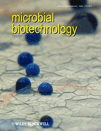
BIOTECHNOLOGY LETTERS
Scope & Guideline
Innovating Solutions for Tomorrow's Challenges
Introduction
Aims and Scopes
- Bioprocess Engineering and Optimization:
Research on the optimization of bioprocesses, including fermentation techniques, enzyme production, and microbial metabolism, aimed at improving yield and efficiency in various biotechnological applications. - Synthetic Biology and Genetic Engineering:
Studies involving the design and modification of biological systems, including the use of CRISPR technology for genome editing, metabolic engineering, and the development of novel biocatalysts. - Microbial Biotechnology:
Focus on the utilization of microorganisms for industrial applications, including bioremediation, bioconversion of waste materials, and the production of biofuels and biopolymers. - Biopharmaceuticals and Therapeutics:
Research dedicated to the development of biopharmaceutical products, including vaccines, monoclonal antibodies, and gene therapies, focusing on innovative delivery systems and therapeutic strategies. - Environmental Biotechnology:
Studies addressing the use of biotechnological approaches for environmental protection, including waste treatment, pollution control, and the sustainable use of resources.
Trending and Emerging
- CRISPR and Advanced Genetic Engineering:
The application of CRISPR technology for precise genome editing is rapidly increasing, marking a trend towards more sophisticated genetic manipulation techniques that enhance productivity and functionality in various organisms. - Microbial Fuel Cells and Bioenergy Production:
Research focused on microbial fuel cells and other bioenergy technologies is trending, emphasizing sustainable energy solutions through biological processes that utilize waste materials. - Biomaterials and Tissue Engineering:
There is a growing interest in the development of biomaterials for tissue engineering applications, highlighting innovations in scaffold design and regenerative medicine. - Machine Learning and AI in Biotechnology:
The integration of machine learning and artificial intelligence in biotechnological research is emerging, with studies focusing on predictive modeling and data analysis to enhance bioprocess efficiencies. - Biodegradable Plastics and Sustainable Materials:
Research into biodegradable plastics and sustainable materials is trending, reflecting increased public and scientific interest in addressing plastic pollution through biotechnological solutions.
Declining or Waning
- Traditional Fermentation Techniques:
Research focused on classical fermentation methods appears to be waning, with a noticeable shift towards more advanced and optimized bioprocessing techniques that leverage modern technologies. - Plant Biotechnology:
Although still relevant, the focus on plant-based biotechnology, including plant tissue culture and genetic modifications in crops, has diminished in favor of microbial and synthetic biology approaches. - Enzyme Characterization without Applied Context:
There is a decline in studies that solely characterize enzymes without demonstrating their practical applications in biotechnological processes, as the field increasingly prioritizes functional relevance.
Similar Journals

BIOSYSTEMS ENGINEERING
Innovating the future of agriculture and engineering.BIOSYSTEMS ENGINEERING, published by Academic Press Inc. Elsevier Science, is a leading journal that has established itself as a key contributor in the fields of agronomy, crop science, animal science, food science, soil science, and control systems engineering. With an impressive position in the 2023 Category Quartiles, featuring Q1 rankings in Agronomy and Crop Science, Animal Science and Zoology, Food Science, and Soil Science, alongside a Q2 ranking in Control and Systems Engineering, this journal stands at the forefront of innovative research. Currently indexed in Scopus, it boasts a commendable track record, with its Agricultural and Biological Sciences rankings placing it in the 95th percentile for Agronomy and Crop Science and the 90th percentile for Soil Science, among others. With a commitment to disseminating critical advancements and fostering scientific dialogue, BIOSYSTEMS ENGINEERING offers an invaluable platform for researchers, professionals, and students alike, seeking to advance their understanding and application of engineering principles in biological systems. As a hybrid journal that provides both subscription and open access options, it ensures broad accessibility to high-quality research that shapes the future of sustainable agriculture and biological systems.

BIOTECHNOLOGY PROGRESS
Connecting Research to Real-World ApplicationsBIOTECHNOLOGY PROGRESS, a prominent journal published by Wiley, stands at the forefront of the biotechnology field, delivering cutting-edge research and emerging trends since its inception in 1985. With an ISSN of 8756-7938 and an E-ISSN of 1520-6033, this journal has carved out a significant niche within the academic community, reflected in its Q2 ranking within the Biotechnology category for 2023. Maintaining a strong presence in the Scopus database, it ranks #111 out of 311 in the categories of Biochemistry, Genetics, and Molecular Biology, demonstrating its commitment to quality and significance in the field. Although it does not offer open access, it remains accessible through various institutional subscriptions, ensuring that vital biological and biotechnological discoveries reach a broad audience, including researchers, professionals, and students. Given its rigorous peer-review process and a focus on innovative methodologies, BIOTECHNOLOGY PROGRESS is an indispensable resource for anyone looking to stay informed about the latest advancements and applications in biotechnology.

TRENDS IN BIOTECHNOLOGY
Cutting-edge Insights into Biotech TrendsTRENDS IN BIOTECHNOLOGY, published by CELL PRESS, stands as a premier journal since its inception in 1983, focusing on the dynamic and ever-evolving fields of bioengineering and biotechnology. With a notable impact factor and ranking in the top quartile (Q1) of its categories for 2023, this journal is recognized for its contribution to advancing scientific knowledge, boasting a Scopus rank of #5/311 in Biotechnology and #5/162 in Bioengineering, placing it in the 98th and 97th percentiles, respectively. Although it does not operate under an open access model, TRENDS IN BIOTECHNOLOGY ensures a rigorous peer-review process that provides a platform for high-quality research that influences both academic and industrial advancements. The journal's objectives encompass the dissemination of cutting-edge research findings, reviews, and insights that foster innovation in biotechnological applications, making it an invaluable resource for researchers, professionals, and students alike. With its broad scope across the intersection of biosciences and technology, TRENDS IN BIOTECHNOLOGY continues to lead discussions and developments that shape the future of the biotechnology landscape.

Biotechnology Journal
Exploring the nexus of microbiology and molecular medicine.Biotechnology Journal, published by WILEY-V C H VERLAG GMBH, stands at the forefront of biotechnological research and innovation, recognized for its significant contributions to the fields of applied microbiology, molecular medicine, and broader biotechnology. With its ISSN 1860-6768 and E-ISSN 1860-7314, this journal has achieved impressive 2023 quartile rankings, positioning itself in Q1 for both Applied Microbiology and Biotechnology and Medicine (miscellaneous), and Q2 in Molecular Medicine, showcasing its impact and relevance within the scientific community. Based in Germany, the journal aims to disseminate high-quality research that drives advancements in biotechnological applications, fostering a platform for researchers, professionals, and students to engage with cutting-edge developments. With its ongoing commitment to excellence, the Biotechnology Journal is an essential resource for those seeking to stay informed about the latest trends and innovations in biotechnology.

MOLECULAR BIOTECHNOLOGY
Fostering Innovation at the Intersection of Science and TechnologyMOLECULAR BIOTECHNOLOGY, published by SPRINGERNATURE, is a pivotal journal in the fields of applied microbiology, molecular biology, biochemistry, and biotechnology. Since its inception in 1994, the journal has aimed to disseminate high-quality research that explores the intersection of molecular biology and technology, fostering advancements in biotechnology applications. With an ISSN of 1073-6085 and an E-ISSN of 1559-0305, it has established itself as a significant contributor to the scientific community, currently holding a Q3 ranking across multiple categories including Applied Microbiology & Biotechnology and Biochemistry in the 2023 metrics. Although not an open access publication, the journal remains accessible through various institutional subscriptions, providing valuable insights and findings to researchers and professionals. Given its ongoing commitment to quality and relevance, MOLECULAR BIOTECHNOLOGY serves as an essential resource for those involved in cutting-edge research and innovation in molecular biotechnology and related disciplines.

APPLIED BIOCHEMISTRY AND BIOTECHNOLOGY
Advancing Innovations in Biochemistry and BiotechnologyApplied Biochemistry and Biotechnology is a leading journal published by Springer, dedicated to advancing research in the interdisciplinary fields of biochemistry, biotechnology, and applied microbiology. Established in 1981, this peer-reviewed journal covers a wide range of topics that encompass innovative techniques, methodologies, and applications of biochemistry and biotechnology in medicine, environmental engineering, and molecular biology. With a Q2 ranking in several categories and an increasing impact factor, the journal demonstrates significant influence and credibility within the scientific community. While traditionally subscription-based, the journal offers avenues for open access through selective agreements, making high-quality research accessible to a broader audience. Researchers, professionals, and students alike will find Applied Biochemistry and Biotechnology to be an invaluable resource for the latest developments and applications in biochemistry and its related fields, aiding in the quest for sustainable solutions and novel biotechnological advancements.

PROCESS BIOCHEMISTRY
Fostering collaboration in the realm of biochemical sciences.PROCESS BIOCHEMISTRY is a premier journal published by Elsevier Science Ltd, dedicated to advancing the field of biochemistry, microbiology, and bioengineering. With an ISSN of 1359-5113 and an E-ISSN of 1873-3298, this renowned journal is recognized for its impactful contributions, as demonstrated by its Q2 ranking in Applied Microbiology and Biotechnology, Biochemistry, and Bioengineering categories as of 2023. Covering a wide array of topics since its inception in 1950, PROCESS BIOCHEMISTRY serves as a crucial platform for researchers and professionals to disseminate innovative findings and develop new insights in enzyme technology, metabolic pathways, and bioreactor design. Although the journal operates under a non-open access policy, it remains vital for those engaged in cutting-edge biochemical research and development. Located in the United Kingdom, it continues to facilitate scientific discourse and foster collaboration among industry experts and academic scholars worldwide.

Microbial Biotechnology
Fostering collaboration in the realm of microbial sciences.Microbial Biotechnology, published by WILEY, stands at the forefront of innovation in the field of applied microbiology and biotechnology, showcasing cutting-edge research and advancements within both academic and industrial contexts. As an Open Access journal since 2012, it ensures that high-quality research is easily accessible to researchers, professionals, and students globally, promoting knowledge sharing and collaboration. With an impressive impact, the journal holds a Q1 ranking in its categories—Applied Microbiology and Biotechnology, Biochemistry, Bioengineering, and Biotechnology—demonstrating its significance in the scientific community. The journal currently boasts a strong Scopus ranking in several relevant disciplines, including a top 10% position in Applied Microbiology and Biotechnology, highlighting its critical role in disseminating influential findings. Designed to foster dialogue and advance technology within the microbial sciences, Microbial Biotechnology is an essential resource for anyone committed to leveraging microbial processes for sustainable and innovative solutions.

Synthetic and Systems Biotechnology
Empowering Global Access to Groundbreaking ResearchSynthetic and Systems Biotechnology, published by KEAI PUBLISHING LTD, is a pioneering open-access journal that has made significant contributions to the fields of applied microbiology, biotechnology, biomedical engineering, genetics, and structural biology since its inception in 2016. With an ISSN of 2405-805X, this journal is committed to fostering innovative research and interdisciplinary collaboration, providing a platform for the dissemination of high-quality studies that push the boundaries of scientific knowledge. Recognized for its excellence, it holds prestigious Q1 rankings in both Applied Microbiology and Biotechnology as well as Biomedical Engineering in 2023, alongside notable Q2 rankings in Genetics and Structural Biology. Researchers, professionals, and students alike can access cutting-edge research that explores the dynamic interplay between synthetic biology and systems biology, driving advancements that could reshape health, industry, and environmental sustainability. By operating under an open-access model, Synthetic and Systems Biotechnology ensures that new findings are accessible to a global audience, thereby maximizing the impact and reach of the published work and paving the way for future discoveries.

JOURNAL OF GENERAL AND APPLIED MICROBIOLOGY
Empowering academic excellence in applied microbiology.JOURNAL OF GENERAL AND APPLIED MICROBIOLOGY, published by the MICROBIOL RES FOUNDATION, is a vital resource in the fields of applied microbiology and biotechnology, as well as in diverse medical applications, serving an academic community dedicated to advancing microbial science. Established in 1955, this journal has a rich history of disseminating innovative research and insights into the intricate world of microorganisms. With an ISSN of 0022-1260 and an E-ISSN of 1349-8037, the journal maintains high scholarly standards and robustness, reflected in its 2023 Scopus rankings placing it in the Q3 and Q4 quartiles within its categories. While primarily based in Japan, the journal engages a global audience, offering valuable contributions that inform both theoretical perspectives and practical applications in microbiology. Despite being a non-open-access publication, it provides pivotal research findings essential for academics, professionals, and students alike, fostering a deeper understanding of microbial impact on health and the environment.